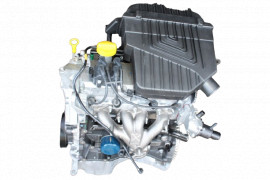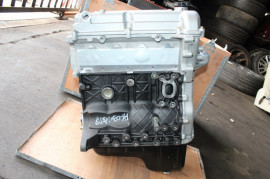Upgrade Your Lorry with a New Opel Corsa Engine
Upgrade Your Lorry with a New Opel Corsa Engine
Blog Article
Checking Out the Inner Functions of a Compact Vehicle's Engine System
As motorists, we commonly take for approved the intricate procedures that take place within the boundaries of our car's engine system. In this expedition of a compact automobile's engine system, we will certainly unwind the internal operations of this mechanical symphony, shedding light on the mysteries that drive us onward on our daily trips.
Burning Process Summary
The combustion process in a compact automobile's engine system is a crucial mechanism that efficiently transforms gas right into power to power the automobile. This process takes place within the burning chamber of the engine, where fuel and air mix, ignite, and generate regulated surges. The combustion procedure consists of four primary phases: consumption, compression, exhaust, and power.
Throughout the intake phase, the piston relocates downward, attracting a combination of air and fuel into the combustion chamber. The next stage, compression, involves the piston moving up, compressing the air-fuel mixture to raise its effectiveness. Ultimately, in the power phase, the spark plug ignites the compressed combination, leading to a quick growth of gases that forces the piston back down. This downward activity creates the power required to drive the lorry. Ultimately, in the exhaust stage, the burnt gases are removed from the burning chamber with the exhaust valve, preparing the chamber for the next cycle. This cyclic burning process is fundamental to the operation of a small car's engine system, making sure efficient energy conversion for propulsion.
Piston and Cyndrical Tube Communication

The piston's accurate fit within the cyndrical tube is important for preserving ideal compression and protecting against power loss throughout combustion. Limited clearances in between the piston and cylinder walls ensure reliable sealing, enabling the piston to relocate efficiently without allowing gases to leak past. Appropriate lubrication is likewise crucial to lower friction and put on between these parts, enhancing long life and performance.
In addition, the layout and materials made use of in producing the piston and cylinder influence engine effectiveness and longevity. Modern engines commonly use lightweight yet resilient materials like aluminum alloys for pistons and cylinder linings to decrease inertia and boost thermal efficiency. Generally, the harmonious communication between the piston and cyndrical tube is fundamental to the engine's functionality and overall performance.
Fuel Shot System Capability
Gas shot systems in portable automobile engines play an essential role in exactly providing gas to the combustion chamber for efficient and regulated ignition. The gas injection system functions by infusing gas into the combustion chamber at the ideal minute during the engine's procedure (opel corsa engine). This accurate timing ensures that the gas blends evenly with the air for correct combustion, causing enhanced gas effectiveness and lowered emissions
There are primarily 2 kinds of gas injection systems used in compact automobile engines: port fuel injection (PFI) and direct gas injection (DFI) PFI systems infuse gas right into the consumption port before the consumption shutoff, while DFI systems inject fuel directly into the combustion chamber. Both systems have their benefits, with DFI providing far better fuel atomization and PFI giving a more affordable service.
Recognizing Engine Air Conditioning Systems
Effective operation of a portable car's engine depends heavily on the effectiveness of its cooling systems. Engine air conditioning is necessary to avoid overheating, which can bring about serious damage and decreased efficiency. The air conditioning system in a portable automobile commonly contains numerous components collaborating to manage the engine temperature level. One critical part is the radiator, which uses coolant to take in heat from the engine. As the hot coolant streams via the radiator, it launches warmth right into the air, cooling off prior to going back to the engine. The water pump distributes the coolant through the engine and radiator, making sure a consistent circulation to regulate temperature level. Additionally, the thermostat assists regulate the coolant More Help circulation to keep ideal engine temperature level. Some cars also have cooling down followers that activate when additional cooling is required, such as throughout rush hour or heat. Comprehending these engine air conditioning devices is vital for keeping the efficiency and long life of a compact automobile's engine system.

Exhaust System Elements Explained
The ideal functioning of a small vehicle's engine cooling mechanisms depends upon a complementary system referred to as the exhaust system, which makes up various crucial components for making sure effective emissions and engine efficiency. The exhaust system includes elements such as the exhaust manifold, catalytic converter, muffler, and tailpipe. The exhaust manifold accumulates exhaust gases from the engine's routes and cylinders them to the catalytic converter. The catalytic converter after that converts hazardous toxins in the exhaust right into less unsafe discharges before releasing them with the muffler and tailpipe.
One vital part of the exhaust system is the oxygen sensor, which checks the oxygen degrees in the exhaust gases to aid regulate gas usage and guarantee optimum engine performance. opel corsa engine. Additionally, the resonator may be present in some exhaust systems to reduce noise degrees. In general, the exhaust system plays an important duty in preserving engine efficiency, lowering dangerous discharges, and making sure a quieter driving experience for small vehicle owners

Verdict
To conclude, the small automobile's engine system is a complex combination of elements that interact to help with the burning procedure, convert gas into energy, and get rid of waste gases. important source Recognizing the internal operations of the engine system, including the piston and cyndrical tube communication, fuel injection system, engine cooling mechanisms, and exhaust system parts, is crucial for maintaining ideal performance and performance of the lorry.
The combustion process in a compact lorry's engine system is a critical system that efficiently converts gas into power to power the car.Gas shot systems in compact vehicle engines play a critical duty in specifically delivering fuel to the combustion chamber for controlled and reliable ignition.There are primarily 2 types of fuel injection systems made use of in compact vehicle engines: port gas injection (PFI) and straight gas injection (DFI) Comprehending these engine air conditioning systems is vital for maintaining the performance find more and durability of a small car's engine system.
The optimal performance of a compact car's engine air conditioning systems depends on a corresponding system understood as the exhaust system, which makes up different crucial parts for ensuring reliable emissions and engine efficiency.
Report this page